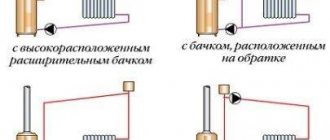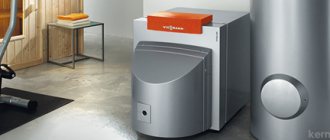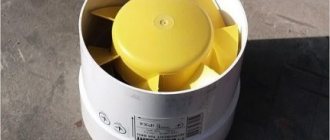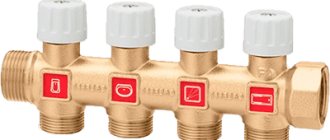Heating with gas from cylinders
Liquefied gas for heating is stored and transported in metal cylinders.
There are often reviews that heating with liquefied gas allegedly requires huge financial expenses. There is an opinion that the purchase of gas equipment, as well as installation and maintenance of the system, is accompanied by excessive costs. But this is not always true, and year after year, heating a private house with liquefied gas in cylinders is gaining new adherents among owners of dachas and cottages.
Advantages of LPG
- Possibility to arrange autonomous heating using liquefied gas at a distance from gas mains;
- Ease of transportation that does not require the construction of pipelines;
- Higher heat capacity of the propane-butane mixture compared to natural gas;
- Environmentally friendly fuel obtained during oil production and refining;
- Relatively low cost in the face of rising prices for other types of fuel.
Disadvantages of LPG
- The cost of gas delivery for heating private houses with liquefied gas in cylinders may increase when the household is located too far from the city;
- In frosty winter, when heating a private house with liquefied gas, the problem of freezing of the gas reducer arises;
- If you create a fuel reserve in a gas tank installed on your site, then during periods of snow drifts there may be difficulties with the refueling vehicle getting to the house;
- The design and installation of autonomous heating using liquefied gas is permitted only with the involvement of specialists from authorized organizations. And only the least critical elements of a liquefied gas heating system can be made with your own hands.
Cost of autonomous gasification of a private house
To calculate the potential costs for autonomous gasification of a site, you need to know the heated area and calculate the degree of intensity of use of the gas system.
The price of a 1000 liter gas holder is approximately 230 thousand rubles, a 1650 liter tank will cost 260 thousand rubles, and a 5000 liter tank will cost 520 thousand rubles.
Some residents are uniting to install an autonomous gas supply system in several neighboring areas.
Of course, the cost of purchasing a gas tank is not the only cost for autonomous gasification of a private home.
However, connecting to main gas pipelines may require significant expenses.
Obviously, in this case, the main requirement is the availability of low-pressure gas networks for connection to centralized networks. If they are not there, then you can wait for years to connect to natural gas.
In this case, the only alternative option is autonomous gasification, which is carried out quickly and relatively hassle-free, and may cost less.
The average cost of connecting to centralized gas supply networks in the Moscow region to the natural gas network is 400 thousand rubles. (provided that a low-pressure gas pipeline runs close to it). The presence of a medium or high pressure gas pipeline is not suitable.
Comparison of different heating cost options
In this table, we analyzed the costs of various types of fuel for heating a residential building with an area of 100 sq.m.
To get more information about the possibility of connecting gas in a private house (to the main gas pipeline), see this article.
Still have questions? Do you want answers to them?
Here you can ask it free of charge to experts or lawyers of the gkh-konsultant.ru portal.
Features of heating with liquefied gas
The owner of a liquefied gas heating system is forced to monitor whether the fuel in the container connected to the boiler is running out. Some may consider this feature an inconvenience, but such a heating system can be autonomous and not depend on problems with the central gas supply. You just need to regularly replace gas cylinders or immediately pump a sufficient amount of gas into the underground storage.
Use of gas cylinders in heating
For ease of use, gas cylinders are combined into a single battery.
The option of heating a house with liquefied gas in 50-liter cylinders is ideally suited for country houses and small cottages. To avoid having to disconnect an empty cylinder every two days and connect a full one in its place, you can combine several cylinders into a battery at once. For this purpose, GOK fittings are used. If a homeowner installs liquefied gas heating with his own hands, he has the right to install a battery of no more than 3 cylinders without a project. A larger number of them will require a project.
Gas cylinders are installed not indoors, but in a metal cabinet on the outside of the house. In winter, there are often cases of reduced gas supply through the reducer due to the fact that the condensate contained in the cylinders partially freezes.
To prevent freezing of gearboxes at low temperatures, you can install a small electric heater in the cabinet with cylinders.
Gas holder for home heating
It is better to refill the gas tank in advance, when weather conditions allow the car to drive up to the house.
It is convenient to use cylinders when gas consumption is not too high, and their delivery service operates uninterruptedly. In other cases, it will be more rational to purchase and install a gas tank - a large underground tank for storing LPG, which will have to be filled with gas only 2-3 times a year. The volume of the gas holder can be from 3 to 10 cubic meters; it is selected in accordance with the power of the heating system.
An underground gas tank is allowed to be located no closer than 10 m from a residential building, and from the road side it must be accessible for a refueling vehicle.
PECULIARITIES
When installing a gas system, it is necessary to install sensors that, in the event of a gas leak, should shut it off. According to existing standards, the tank must be placed at least ten meters from the house. Therefore, it is problematic to install a gas tank on a plot of six acres. However, such a system can be used for several houses by allocating a common area away from the buildings. B
Most companies that install gas tanks require that liquefied gas be purchased only from certain suppliers. They say that otherwise they do not guarantee the normal operation of the equipment. But unlike gasoline prices, the state does not regulate the price of such gas.
CAREFULLY
“Approximately 20 percent of gas tanks in the country are restored,” warns Alexey Vasiliev, a representative of the Society for the Protection of Consumer Rights. Spent gas tanks are purchased in Europe as scrap metal.
In Russia, the old anti-corrosion coating is removed from the tank and a new one is applied. Such a container costs two to three times less.
“It’s difficult for a non-specialist to distinguish an old gas tank from a new one,” says Vasiliev. “On the shell of restored tanks there is always a section, usually circular in shape, that was opened to treat the inside of the tank and then sealed again.”
But how such a gas tank will behave under the pressure of liquefied gas is always a mystery. Therefore, it is better not to take risks and save money.
The average cost of equipment and installation of an autonomous gasification system is 0.5 million rubles. It costs 1-1.5 million to install equipment and connect to the main gas pipeline. From 2 to 20 thousand liters the capacity of the gas tank. Depending on your needs (the house is used in the summer or all year round), you will have to fill the tank once or twice a year.
The service life of the gas tank is 30-50 years.
Gas from the main pipeline costs 4 rubles/liter.
Year-round heating of a house of 200 square meters will cost 30-40 thousand rubles.
On average, gas costs 15 rubles/liter when refilling an autonomous system.
Year-round heating of a house of 200 square meters will cost approximately 150 thousand rubles.
Calculation of costs for the installation of autonomous gas heating
When comparing which types of heating systems will be the least expensive, you must first pay attention to the consumption of liquefied gas for heating. It is advisable to compare the upcoming costs with similar costs for other types of fuel and decide which option will be more profitable.
Initial costs for equipment and arrangement
The costs of purchasing equipment and installing an autonomous liquefied gas heating system in your home may vary slightly in different regions of residence. But in general, when compared with connecting to the main gas pipeline, the difference in cost will be insignificant. It will be more expensive only if you use not cylinders, but a gas holder with a volume of several cubic meters. Its cost will be more than 300,000 rubles.
Also, the cost of arranging premises for boilers using LPG is almost equal in cost compared to those using diesel fuel. As evidenced by reviews, heating with liquefied gas only requires higher initial costs when it serves as an alternative to solid fuel or electric heating. But during further operation, the funds invested in heating a private house with liquefied gas will gradually pay off due to the profitability of this type of fuel.
Gas costs for heating a private home
Just a few years ago, a propane-butane mixture was much more expensive than main gas (methane), but over time the price difference between them is decreasing. Therefore, relative indicators of the cost and consumption of liquefied gas for heating demonstrate the feasibility of using this energy carrier.
| Type of fuel | Specific heat of combustion, mJ | Retail cost of fuel, rub. | Cost of kW/h energy, rub. |
| Propane-butane mixture (LPG) | 45–47 | 20–24 (per 1 kg) | 1,7–2,0 |
| Natural gas | 32–40 | 5.2–5.6 (per 1 m³) | 0,6–0,9 |
| Diesel fuel | 40–42 | 23–27 (per 1 liter) | 2,6–2,8 |
| Electricity | — | — | 3,5–3,8 |
The simplest way to determine the real consumption of liquefied gas for heating a house is to correlate the mass of gas in one cylinder with the technological characteristics of the heating equipment. In this case, it is more convenient to calculate the consumption by weight, since the volume (in liters) depends on the density and percentage composition of the propane-butane mixture pumped into the cylinder.
A standard 50-liter cylinder can be filled with 35–40 liters of LPG, which in terms of weight gives an average of 22 kg of gas.
Let's look at a specific example to determine the required amount of liquefied gas in cylinders for heating a house with an area of 100 m²:
- To heat the specified area you will need (at maximum standards) 10 kW of heat energy;
- However, the boiler does not operate constantly at maximum mode, and its average load factor can be taken as 0.5. This means we need 5 kW;
- With a calorific value of liquefied gas of 46 mJ/kg, to produce 1 kW of heat energy, about 0.1 kg of LPG will be consumed per hour, and for 5 kW, 0.5 kg of LPG will be required;
- 12 kg, or almost half of the cylinder, will be consumed per day;
- The monthly consumption of liquefied gas for continuous heating of the house will be approximately 13–15 cylinders.
The volume of the gas holder may be enough to operate the heating system throughout the entire season.
What will the consumption be if you do not use cylinders, but pump fuel into the gas holder? How often will you have to call a gas station to replenish the gas supply in the “five cubic meter” tank that is most common among consumers? Let's figure it out:
- Any of the containers for liquefied gas is not filled “to the neck”, but only 80–85%. Accordingly, a tank with a volume of 5 m³ will contain about 4250 liters or (in terms of weight) 2300 kg of gas;
- We have already determined that in our case, the liquefied gas heating system consumes 0.5 kg of fuel per hour;
- We divide the total mass of gas contained in the gas tank 2300 kg by 0.5 kg/hour, and we get 4600 hours - for such a time we have enough fuel reserve;
- Dividing 4600 hours by 24, we get a total of 190 days. That is, one refill of a gas tank with a volume of 5 m³ is enough to heat a 100 m² house for almost the entire heating season (in a temperate climate).
These are theoretical calculations, but in reality, fuel consumption can be significantly reduced. With the correct setting of combustion modes, a gas heating boiler for liquefied gas can consume 1.5–2 times less fuel, and the temperature in the house will be maintained at an acceptable level.
To reduce the amount of gas burned, use automation, which switches the boiler to moderate mode at night, reducing the temperature in the system by 7–9 degrees, thereby achieving a cost reduction of 30%.
Climate
-18 votes
+
Vote for!
—
Vote against!
It often happens that it is not possible to connect a building to centralized heating. If the owner, after going through all the options, decides on a heating method such as liquefied gas, he should take into account all the nuances, calculate the consumption of liquefied gas for heating the house and weigh whether this method of heating the home is rational.
Table of contents:
- What is liquefied gas
- Safe use of liquefied gas at home
- Liquefied gas for home heating
- Features of residential heating using liquefied gas
- Liquefied gas consumption for home heating
- Heating your own home with liquefied gas
- The order of organizing heating using liquefied gas
- Consumption of liquefied gas for heating a house of 100m2 and 150m2
- Heating a house with liquefied gas in cylinders, reviews
What is liquefied gas
Liquefied gas is natural gas that has changed its state of aggregation and turned into liquid, significantly decreasing in volume. The transition requires low pressure and normal temperature. As a result, a significantly larger volume of fuel is stored in gas conservation tanks.
The cylinders are filled with a mixture of propane and butane, which remains in a liquid state under high pressure. This makes transportation easier and safer. There are three options for fuel used to fill cylinders, depending on seasonality:
- technical butane;
- technical mixture of propane and butane (summer version);
- technical mixture of propane and butane (winter version).
In order not to face the problem of the inability to heat in winter due to high frosts, it is necessary to insulate the boxes where the cylinders are stored and equip them with a heater. At low temperatures, the gas does not freeze, but turns into liquid and does not enter the heating system. This happens because the mixture boils at a temperature of ten degrees below zero, and the pressure drops. To prevent this from happening, in addition to insulation and heating during outdoor installation of cylinders, the cylinders are blown from the boiler room through specially made air vents.
Safe use of liquefied gas at home
A mixture of liquefied gas is much heavier than air. And if gas leaks from cylinders, it always collects above the floor surface, and the presence of gas in the room can be felt already when it reaches a critical explosive level. For this reason, the gas cylinder should only be installed outdoors, in a special metal compartment in a vertical position. The device must be equipped with holes for ventilation.
It is strictly forbidden to place gas cylinders under the house in basements or pits in the yard.
There are the following categorical “Don’ts” when using liquefied gas:
- in case of freezing, it is prohibited to heat the cylinder with electrical appliances or heating elements;
- structures with a balloon installation are located on the outside of the home and preferably on the north side, to prevent exposure to sunlight;
- the cylinder is filled to less than eighty percent of its volume, the remaining percent of the space is given for expansion;
- systematically check cylinders for leaks;
- gas pipelines must be made of reliable and powerful materials.
Liquefied gas for home heating
The presence of gas cylinders with propane and butane in suburban homes no longer surprises anyone. People where gas is not installed actively use this option in the kitchen, for canning, and cooking. But lately you can increasingly hear that country houses are heated using liquefied petroleum gas, LPG. Recently, purchasing equipment and installing a heating system has become quite affordable for the general population. More and more people who do not have the opportunity to receive centralized gas for heating are installing equipment for heating with liquefied gas.
Among the advantages of this option of using liquefied gas, the following features stand out:
- the ability to make independent autonomous heating in a place where it is impossible to use centralized heating;
- You can use gas all year round;
- the system is characterized by high quality and reliable operation;
- the gas holder is a small and visually invisible tank that does not take up space as it is located underground;
- ease of delivery of raw materials, which does not require the construction of a pipeline;
- liquefied gas has a higher heat capacity than natural gas;
- raw materials are considered environmentally friendly;
- Compared to other heating options, the low cost of gas, which does not depend on fluctuations in the cost of natural gas.
But we cannot help but mention the disadvantages of using liquefied gas:
- provided that the home is located far from the city, the cost of raw materials may increase due to travel costs;
- in high frosts when using liquefied gas, there is a danger of freezing of the gas reducer;
- Due to bad weather conditions, roads may be swept away, making it difficult to bring in new fuel supplies;
- designing and installing an autonomous heating installation using liquefied gas is permissible only for qualified specialists who are familiar with the issue; only the simplest components can be made independently.
Features of residential heating using liquefied gas
One of the main inconveniences is that the owner must constantly monitor the gas level, monitor reserves and replenish them on time. Independence from the central gas supply and complete autonomy is considered an advantage for some, and a disadvantage for others. But with responsible control of inventory levels, there will never be problems or interruptions in heating.
A fifty-liter cylinder is filled with liquefied gas and serves as fuel for heating small-sized dachas, cottages and houses. Every few days, changing an empty cylinder to a full one is quite inconvenient, so experts advise connecting several cylinders into a battery and looping them. When installing a liquefied gas heating system yourself, it is permissible to make a battery of three cylinders. If you want to combine a larger number, you need to prepare a project and documents.
Gas cylinders must not be installed indoors. They are located only on the outside of the house in a special metal cabinet. In frosty weather, there are cases of freezing of the reducer or condensation, which makes it difficult to supply gas. To avoid such inconveniences, a small electric heater is installed in the closet.
Heating with liquefied gas is especially convenient if the building area is not very large and there is confidence that there will be no problems with access to raw materials. If this point is in question, it would be better to purchase a gas tank. This is such a large bunker for filling liquefied gas and storing it; such a tank is filled once every two to three years. The volume of the tank may vary. The owner selects it according to his needs: from three to ten cubic meters. The gas tank can be placed at a distance of at least ten meters from the home, and a convenient access road must be provided to the tank.
Liquefied gas consumption for home heating
The most important question that worries the future user of such a heating system is: “Is gas-cylinder heating rational?” On the one hand, to build a heating system you will not need many items and it seems very simple. Is it really? To build a liquefied gas heating system you will need:
- buy a special gas boiler that can operate on raw materials such as gas cylinders or independently rebuild the control system and replace nozzles;
- buy fittings, gearboxes and gas equipment;
- connect all mechanisms and set up the heating system.
The question of the amount of gas that is spent on heating the house and the ability to warm up the entire cubic capacity of the home is one to which you need to calculate the answer in advance. As can be seen from the reviews of users of such a system, provided that the house is not sufficiently insulated and the total area is over two hundred square meters, it is better not to install such a heating system. It will be unreasonably expensive. In this case, you should switch to solid fuel boilers.
Heating your own home with liquefied gas
Heating a country house with liquefied gas is an excellent option for residents of remote settlements where gas supply is very expensive or even impossible. In this case, using liquefied gas to heat your home is an excellent solution. User reviews claim that this kind of heating is an alternative to any other and even the once popular diesel fuel. Gas tanks located in the yard ensure uninterrupted gas supply. When installing a tank, it is important to take into account the requirements for the required distance from the house - at least ten meters and the distance to communications - no closer than two meters. The container is selected taking into account the individual needs of the home and the boiler. In private buildings, when using liquefied gas during the heating period, boilers with a power of up to ninety kilowatts are installed, the storage capacity ranges from three to nine cubic meters. Replenishment of supplies in the storage facility is carried out using a special machine that delivers liquefied gas as needed.
Liquefied gas is recognized as an economical fuel. You can heat a fairly large room relatively inexpensively.
For example, to heat an area of two hundred square meters, you need to purchase a boiler with a capacity of twenty kilowatts. For such a unit you will need a five-cubic-meter gas tank, which requires refilling, depending on the temperature, no more than once a year.
The order of organizing heating using liquefied gas
It is necessary to understand that it is impossible to do the work of installing a heating system on your own, without special education and experience. All these stages: design, installation, installation of the gas tank, connection of related equipment, should be carried out only by craftsmen. It would be a good idea to check their permits and licenses for carrying out this type of work. It is not difficult to find specialists in installing an autonomous gas supply; currently there are many offers from companies capable of creating a gas supply and heating system.
When installing a gas supply, you should follow the instructions, which guarantee the reliability, safety and high-quality operation of the heating system:
- drawing up project documentation is the first stage, during which a decision is made on the type of system, pricing policy, productivity, power and other parameters are calculated;
- purchasing equipment – there have been no problems with purchasing equipment for a long time, a large number of companies offer gas equipment for autonomous heating, and you can choose an option based on the price; video guides are offered on the operation of the equipment, which helps make a purchasing decision;
- installation and commissioning of the heating system - the performance of this work by professionals guarantees the smooth and efficient functioning of the equipment over a long period of time;
- filling the system with liquefied gas;
- equipment maintenance.
If there is no desire or opportunity to install a gas tank, then heating is done using cylinders combined into a battery. This is the same heating, but the boiler will work not from a storage tank, but directly from cylinders. For small buildings, cottages and summer houses, this is a suitable option, since it is not always possible to place storage in a small area, taking into account the required distances from the reservoir to your own and neighboring buildings.
Consumption of liquefied gas for heating a house of 100m2 and 150m2
It is an indisputable fact that the better the house is insulated, the lower the gas consumption. It is necessary to insulate all problem areas: the attic, windows, floors and walls. If we talk about heat loss through these areas, then schematically the heat loss looks like this:
- Thirty-five percent of heat is lost through the roof;
- at least twenty-five percent of heat is lost through the attic;
- Twenty-five percent of the heat escapes through uninsulated windows;
- Ten percent come through the doors;
- the floor depletes the room by ten percent.
You can calculate fuel using the formula. To find the required amount of gas, you need to divide the heating power by the minimum specific heat in kilowatts and multiply by the efficiency of the boiler. Experts have calculated the cost of different types of fuel when heating a house of one hundred square meters for six months. It makes no sense to give numbers, since prices for everything change, but among all the options:
- main gas;
- pellets;
- coal;
- firewood;
- bottled gas;
- diesel fuel;
- electricity.
The leader in cost, that is, the most expensive, was heating using electricity and diesel fuel. The cheapest option is centralized gas heating, which, unfortunately, is not always available. This is why we have to look for alternative options, one of which is liquefied gas.
When calculating the consumption of raw materials, use the above formula. The result is calculated in kilograms, but the answer is converted to liters. Then we multiply by the number of days that the heating will work. If we take the average boiler efficiency of ninety-two percent, then a house of one hundred square meters will need approximately five hundred and seventy liters. As for a dwelling with a cubic capacity of one hundred and fifty square meters, the consumption is at least eight hundred and forty liters. The cylinder that is used is usually forty-two liters of gas. Dividing the amount of gas required for heating by the amount of gas in the cylinder, that is, forty-two, we obtain the number of cylinders. And when we multiply the result by the cost of liquefied bottled gas, we find out the amount needed to heat the home throughout the entire season.
Heating a house with liquefied gas in cylinders, reviews
Reviews of those who heat their home with liquefied gas agree on one thing - the home must be insulated so that there is no overconsumption of gas. Consumption depended on weather conditions and the cubic capacity of the house.
A well-insulated dwelling with an area of one hundred and fifty square meters, at a fixed set temperature of twenty-three degrees, for heating with liquefied gas cylinders required the following amount of raw materials:
- when the air temperature was from zero to five above zero, four cylinders were needed - November;
- at temperatures from minus ten to minus twenty-eight, ten cylinders were used up - December;
- at temperatures from five to twenty below zero, eight cylinders were used up - January;
- at temperatures from five to fifteen below zero, seven cylinders were used;
- when the temperature ranged from five degrees below zero to five degrees above 0, six cylinders were needed.
As you can see, during the heating season of five months, the user used thirty-five cylinders.
The efficiency of heating using liquefied gas is high in the absence of other sources. Each region has its own priority fuel or heating option, depending on the climate and the availability of one or another option. The discussion about which type is cheaper and has a higher priority is unreasonable.
If you do not install a gas tank, then you should take into account the fact that gas cylinders will have to be taken to a gas station, which will entail additional financial and time costs.
Experts insist that heating with liquefied gas will be profitable under the following conditions:
- the dwelling does not have a very large area - about one hundred square meters;
- the house must be properly insulated;
- heating with this type of raw material is temporary and in the future it is planned to connect to a centralized gas system, in which case you will not have to spend money on purchasing an additional boiler;
- There is a backup heating option, which in case of unforeseen situations will help to cope with the problem of heating the home.
If the cylinders operate in isolation, without being connected to a battery, you must have at least three of them: one for the operation of the boiler installation, the second for shifting, and the third as a reserve in case of unforeseen circumstances.
Heating with liquefied gas is a convenient and affordable option if it is impossible to use centralized gas. You must follow all recommendations and adhere to safety precautions. In this case, your home will always be warm and cozy.
Heating equipment for heating with liquefied gas
A liquefied gas boiler is distinguished by its safe design and reliable operation.
To heat a private house using liquefied gas, both heating boilers with a water circuit and gas convectors are used. But among all types of similar equipment, liquefied gas heating boilers still lead as the most productive. Reviews of liquefied gas heating using convectors are rarely positive.
Gas heating boilers for liquefied gas are almost no different in design from those that consume mains gas. The only difference is in the design of the burners, since the pressure of propane-butane coming from the cylinder is almost 2 times higher than natural methane. Accordingly, the jets in the burners also differ in internal diameter. There are also some differences in the devices for regulating the air supply.
Gas heating boilers for liquefied gas are almost no different in design from those that consume mains gas. The only difference is in the design of the burners, since the pressure of propane-butane coming from the cylinder is almost 2 times higher than natural methane. Accordingly, the jets in the burners also differ in internal diameter. There are also some differences in the devices for regulating the air supply.
The design differences are so insignificant that, if necessary, it is enough to just replace the burners in a boiler designed for methane, and you will not have to buy a new liquefied gas heating boiler.
Let's look at the differences between the main models of boilers for liquefied gas heating systems:
- Boiler type . Among the units for heating a private house with liquefied gas in cylinders, single-circuit and double-circuit boilers are distinguished. The former serve only for the heating system, and the latter, in addition, provide hot water. The combustion chamber in boilers is designed differently; it can be open or closed. Both large floor-standing models and compact wall-mounted ones are available;
- Efficiency . Judging by the reviews, heating with liquefied gas can become truly rational and economical if the gas boiler has an efficiency of at least 90-94%;
- Boiler power . It is considered one of the main parameters when heating a private house with liquefied gas. It is necessary to make sure that the specifications of the unit will allow it to develop sufficient power to provide the entire area of the home with heat, but at the same time avoiding excessive consumption of liquefied gas for heating;
- Manufacturer . While pipe routing in a liquefied gas heating system can be done with your own hands, a gas boiler should in no case be homemade. Moreover, it is advisable to give preference to well-established domestic or foreign manufacturers.
Liquefied gas boilers are prohibited from being installed in basements, since the propane-butane mixture is heavier than air. When leaked, such gas does not disappear, but accumulates at floor level, which can lead to an explosion.
Documentation and design
An owner who organizes an autonomous gas supply for a country house often has a question: is it necessary to register a gas tank installed on an individual plot with government organizations.
In accordance with Federal norms and rules (clause 215), the following containers operating under pressure are not subject to registration:
- Gas carrier tanks designed to transport liquid gas.
- Car gas cylinders.
- Other containers whose volume does not exceed 100 liters.
If the owner enters into an agreement with an organization that has the right to install and service equipment with the appropriate license, its authorized representatives deal with registration issues, and everything the homeowner needs to know about LPG is to conclude an agreement.
When drawing up a contract, you should take into account the list of obligations that the contractor accepts; it usually contains the following points:
- Submission of an application by the contractor to the supervisory authorities indicating information about the company, the location of the gas tank and the features of its operation, if any.
- Submission of a report to the regulatory authority on the readiness of the gas supply system for operation and a copy of the order to put it into operation.
- Submission of information about the tank indicating its technical characteristics, the gas mixture used, and the date of the last inspection.
Rice. 5 Cost of installation of gas tanks - example
The autonomous gasification system does not require complex design solutions and is quite simple to install when placing an underground tank with a volume of up to 10 cubic meters. The following standards must be observed (SNiP 42-01-2002):
- The distance from public buildings is at least 15 m, from residential buildings 10 m.
- From garages and playgrounds - 10 m.
- From sewers, heating routes, communications and ground structures, underground wells, trees - 5 m.
- From water supply and non-channel communications, fences - 2 m.
- If there are power lines nearby, at least half the height of the support.
When designing, the convenience of access roads, the volume of gas tanks, and soil characteristics (electrochemical activity, magnitude of stray currents) are taken into account; based on the information received, the type of tank protection is selected.
Fuel costs
Let's start with them, because here a more unambiguous assessment and comparison is possible. After all, the efficiency of gas-consuming equipment when operating on different types of gas is the same, and prices for liquefied and main gas change synchronously, and their ratio remains practically unchanged.
Let's compare the specific energy intensity of both types of fuel.
The density of liquefied propane at normal temperature is 0.493 kg/l, and the specific heat of combustion is 48 MJ/kg, resulting in 23.664 MJ/liter. The density of liquefied butane is 0.58 kg/l, the specific heat of combustion is 45.8 MJ/kg, we get 26.564 MJ/liter. Since in Russia a mixture of propane and butane in equal proportions is usually used as liquefied hydrocarbon gas (LPG), which is poured into gas tanks, we take the average value - 25.114 MJ/liter.
The basis of the main gas is methane, the specific heat of combustion of which is 33.066 MJ per 1 cubic meter. meter. Consequently, in terms of energy intensity, 1 liter of liquefied hydrocarbon gas is equivalent to approximately 0.75 cubic meters of main gas.
Now let's compare prices.
During this period in Russia, the average price of 1 liter of liquefied gas is about 20 rubles, which gives approximately 0.8 rubles per MJ. The cost of a cubic meter of natural gas is about 5 rubles, which gives 0.15 rubles per MJ.
Consequently, each calorie of heat and each kilowatt-hour of electricity generated using main gas costs more than 5 times less, and this ratio will remain virtually unchanged regardless of any price fluctuations.
Comparison of gas from the main and gas tank
When comparing both options for gas supply to a private home, it is necessary to look at both the cost of purchasing a cubic meter of gas, as well as the cost of installing equipment and the cost of its subsequent operation.
All parameters of both systems should be taken into account. At the same time, when choosing which is initially cheaper - a gas tank and main gas, it is necessary to analyze what is easier to repair and maintain.
The main advantage of a gas tank over gas from a pipe is the high speed of connection; if in the first case 1–3 days are enough, in the second everything can drag on for many months
A gas holder is, first of all, complete autonomy in the energy supply of a private home. The main gas can be turned off at any time. It is impossible to completely insure against accidents on gas pipelines.
In this respect, piped blue fuel is similar to electricity. The general network collapsed, and the cottage found itself without electricity and gas supply. And gas holder fuel is always available. You just need to make sure the tank is full.
Factor #1: Connection cost
If you look at the average prices for connecting main gas and installing a gas tank, then the first option wins greatly. You can now connect a cottage to the gas main for 50-100 thousand rubles.
If you choose the second method, you will have to spend about 200 thousand rubles on gas tank equipment alone. The larger it is, the more expensive it is. Plus installation and excavation work. But there are a number of nuances here.
If there is no gas main in the village, then a gas holder is an excellent way to heat a house. In terms of energy efficiency and fuel costs, LPG is many times superior to coal, firewood and electricity
The main problem with connecting main gas is the timing of all necessary work and approvals. If the village already has a pipe, then everything will happen relatively quickly and quite inexpensively. But if there are more than two hundred meters from the house to the highway, then there will be a lot of hassle with connecting.
To connect the cottage to the gas pipe, you must:
- Prepare gas consumption calculations.
- Apply for technical conditions.
- Get these specifications (takes up to a month).
- Prepare a project for the gas network in the house and from it to the main line (a couple more weeks).
- Conclude a connection agreement with gas workers by providing them with project documentation.
- Complete the installation of gas equipment (several days, provided that free installers are quickly found).
- A representative of the main methane supplier checks the functionality of the equipment and wiring both inside and outside the house, followed by the conclusion of a service agreement (you can wait another month for this person’s arrival).
As a result, the minimum is 3-4 months. And this is if no problems arise during the approvals and installation process. Usually everything drags on for six months; the price of connecting to a centralized gas supply also makes you think about its necessity.
If the village is not included in the regional gasification program, thanks to which many connection issues have already been resolved, then there is no point in dealing with this topic yourself. There will be a lot of headaches and going through the authorities.
But the process of gasifying a private house using a gas holder occurs in just 1–3 days. Private owners do not need to obtain approval from supervisory authorities for the installation of such an installation on their land. Our recommended article will help you determine the cost of installing a gas tank.
You just need to dig a pit for the LPG tank, install it there and connect the pipes to it. All the necessary sensors, automatic control systems and valves are already included in the gas tank kit.
And one more nuance. The connection from the highway to the house can be done on almost any site. With a gas holder the situation is radically different. It must be removed at a certain distance from buildings, wells and roads. Not every estate is suitable for placing gas tank equipment; a suitable place for the tank may not be found.
Factor #2: Energy Efficiency and Cost of Maintenance
When analyzing expenses for gas fuel, it is necessary to separate the cubic capacity (displacement) of methane in the pipe and propane-butane LPG in the car delivering liquefied fuel to the customer. If you look at the price tag in rubles/m3, it turns out that main gas costs three to four times less than propane-butane.
However, in the first case, fuel is supplied in a gaseous state, and in the second, in a liquid state. As a result of evaporation, a liter of this “liquid” turns into 200–250 liters of gas. Moreover, here it is also necessary to take into account the ratio of propane and butane in the gas holder LPG. They have different densities.
On the one hand, mainline natural gas is cheaper than LPG for a gas tank in terms of cost per cubic meter, but on the other hand, it has a lower specific heat capacity
If we compare the calorie content of two types of gas fuel, then propane-butane will be ready to give a head start to methane. When burning one cube of a propane-butane mixture in a gaseous state, about 28 kW is released, while methane can produce only about 9 kW.
With an average calculation, a cottage of 100 square meters requires about 3000–3100 m3 of methane or about 1000 m3 of LPG per year for heating. At the same time, you will have to pay three to four times less for the first gas. As a result, it turns out that fuel costs for the year as a whole end up being approximately equal.
Maintenance of gas tanks and gas pipes from the main to the house is carried out by specialized organizations that also supply gas
According to the standards of the Ministry of Emergency Situations, main natural gas belongs to the 4th, safest category of explosive gas substances. But propane-butane is included in the more dangerous 2nd group. Even with small concentrations of LPG in a room, it can explode from the slightest spark.
Moreover, methane itself is light; during leaks, it rises under the flow and dissipates or goes into ventilation. But the propane-butane mixture is heavy and sinks to the floor or ground, gradually accumulating there to critical levels.
From a safety point of view, main gas greatly outperforms tank gas. It is not for nothing that gas tanks are strictly prohibited from being installed next to wells and basements, where gas can leak due to leaks from the tank.
The standard distances for the location of the gas tank on the site are given here. The article we recommend describes in detail the rules for choosing a location for installing equipment of this type.
To avoid problems with LPG, tanks for it and rooms with boilers are often equipped with special gas sensors. They instantly react to an increase in gas concentration, warning the home owner about potential problems. You shouldn't skimp on them.











